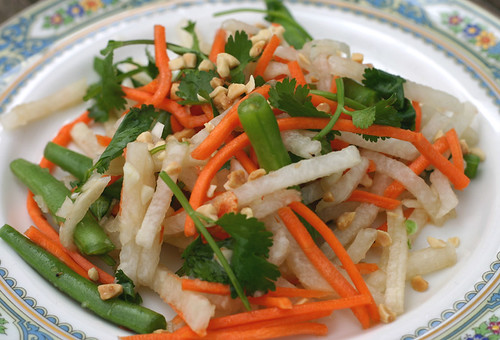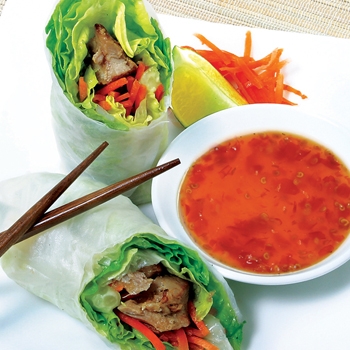THAI CUISINE
 Thai food - as exotic as it is - needs no introduction and is internationally famous.The juxtaposition of sweet, sour, hot and salty flavours is what makes Thai cuisine so distinct.
Thai food - as exotic as it is - needs no introduction and is internationally famous.The juxtaposition of sweet, sour, hot and salty flavours is what makes Thai cuisine so distinct.
Originally, Thai cooking reflected the characteristics of a waterborne lifestyle.Aquatic animals, plants and herbs were major ingredients.With their Buddhist background, Thais shunned the use of large animals in big chunks. Big cuts of meat were shredded and laced with herbs and spices. Traditional Thai cooking methods were stewing and baking, or grilling.
Thai Meal Comprises--
Cuisine is a specific set of cooking traditions and practices, often associated with a specific culture. A cuisine is primarily influenced by the ingredients that are available locally or through trade.
Whether chilli-hot or comparatively blands, harmony is the guiding principle behind each dish. Thai cuisine is essentially a marriage of centuries-old Eastern and Western influences harmoniously combined into something uniquely Thai.
Originally, Thai cooking reflected the characteristics of a waterborne lifestyle.Aquatic animals, plants and herbs were major ingredients.With their Buddhist background, Thais shunned the use of large animals in big chunks. Big cuts of meat were shredded and laced with herbs and spices. Traditional Thai cooking methods were stewing and baking, or grilling.
The ideal Thai meal is a harmonious blend of the spicy, the subtle, the sweet and sour, and is meant to be equally satisfying to eye, nose and palate. A typical meal might include a clear soup (perhaps bitter melons stuffed with minced pork), a steamed dish (mussels in curry sauce), a fried dish (fish with ginger), a hot salad (beef slices on a bed of lettuce, onions, chillies, mint and lemon juice) and a variety of sauces into which food is dipped. This would be followed by sweet desserts or fresh fruits such as mangoes, durian, jackfruit, papaya, grapes or melon
Titbits-
 These can be hors d'oeuvres, accompaniments, side dishes, and/or snacks. They include spring rolls, satay, puffed rice cakes with herbed topping. They represent the playful and creative nature of the Thais.
These can be hors d'oeuvres, accompaniments, side dishes, and/or snacks. They include spring rolls, satay, puffed rice cakes with herbed topping. They represent the playful and creative nature of the Thais.Salads-
 A harmony of tastes and herbal flavours are essential. Major tastes are sour, sweet and salty. Spiciness comes in different degrees according to meat textures and occasions.
A harmony of tastes and herbal flavours are essential. Major tastes are sour, sweet and salty. Spiciness comes in different degrees according to meat textures and occasions. Dips-Dips entail some complexity. They can be the major dish of a meal with accompaniments of vegetables and some meats. When dips are made thinly, they can be used as salad designs. A particular and simple dip is made from chilies, garlic, dried shrimps, lime juice, fish sauce, sugar and shrimp paste.
Dips-Dips entail some complexity. They can be the major dish of a meal with accompaniments of vegetables and some meats. When dips are made thinly, they can be used as salad designs. A particular and simple dip is made from chilies, garlic, dried shrimps, lime juice, fish sauce, sugar and shrimp paste.Soups-
A good meal for an average person may consist simply of a soup and rice.
Traditional Thai soups are unique because they embody more flavours and textures than can be found in other types of food.
Curries-Most non-Thai curries consist of powdered or ground dried spices, whereas the major ingredients of Thai curry are fresh herbs. A simple Thai curry paste consists of dried chilies, shallots and shrimp paste. More complex curries include garlic, galangal, coriander roots, lemon grass, kefir lime peel and peppercorns.

Single Dishes -Complete meals in themselves , they include rice and noodle dishes such as Khao Phat and Phat Thai.
 Desserts-
Desserts-
No good meal is complete without a Thai dessert. Uniformly sweet, they are particularly welcome after a strongly spiced and herbed meal.
As an acknowledged expert of Thai cuisine, David Thompson, explains Thai food (from a Western perspective): "Thai food ain't about simplicity. It's about the juggling of disparate elements to create a harmonious finish. Like a complex musical chord it's got to have a smooth surface but it doesn't matter what's happening underneath. Simplicity isn't the dictum here, at all. Some westerners think it's a jumble of flavours, but to a Thai that's important, it's the complexity they delight in."

